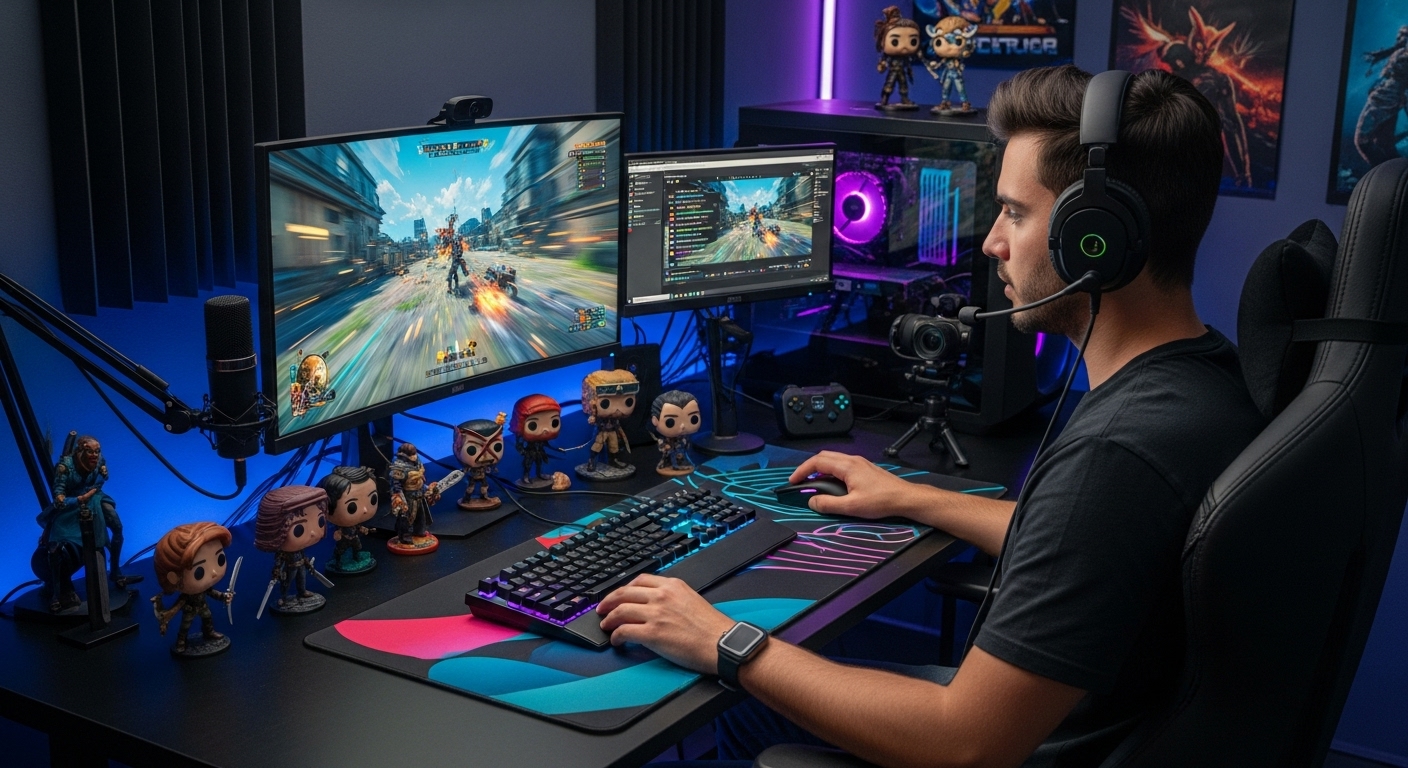Gaming has come a long way from its simple origins. What began as a niche activity in the 1950s has transformed into one of the largest and most influential forms of entertainment in the world today. Whether it’s casual mobile games, expansive online multiplayer worlds, or the rise of virtual reality, the gaming industry continues to evolve at a rapid pace. In this blog post, we’ll explore the journey of gaming, from its humble beginnings to the massive global phenomenon it is today, and discuss where it might be headed in the future.
The Early Days of Gaming: Origins and Pioneers
The history of video games is rooted in the broader history of computing. In the 1950s and 1960s, scientists and engineers began experimenting with computer graphics and interactive entertainment. While many of these early “games” were limited to being simple demonstrations or experiments, they laid the groundwork for the video game industry that would soon follow. The first true video game, “Spacewar!” created by Steve Russell in 1962 at MIT, was a two-player game played on a massive computer. It featured spaceships and a star at the center of the screen and was displayed on a primitive CRT monitor. “Spacewar!” was the first video game that caught the attention of the wider world, though it remained mostly a hobby for programmers and scientists.
The 1970s marked the beginning of video games becoming more accessible to the public. The release of Pong in 1972 by Atari founder Nolan Bushnell is often regarded as the first commercially successful arcade game. Pong was a simple simulation of table tennis, with players controlling paddles to hit a ball back and forth. The game’s success was revolutionary, setting the stage for the arcade gaming boom that would follow.
Following Pong, games like Space Invaders (1978), Pac-Man (1980), and Donkey Kong (1981) emerged, further cementing the arcade’s place in popular culture. These games, though rudimentary by today’s standards, captured the imaginations of players worldwide. The arcade was where many people first discovered the excitement of video gaming, and it became a social hub where people could come together to compete for high scores and enjoy a shared experience.
Home Consoles Enter the Scene: The Birth of Gaming in Living Rooms
While arcade games dominated the 1970s, the 1980s brought the shift to home gaming consoles. Before long, it became clear that people wanted to play games in the comfort of their own homes, and that’s where companies like Atari, Nintendo, and Sega came in. The early 1980s saw the rise of the Atari 2600, a console that used cartridges to play a variety of games, from Space Invaders to Pitfall!. The Atari 2600 brought gaming into the living room, allowing players to enjoy arcade-quality games without leaving the house. However, the early success of the console was followed by a massive crash in 1983, caused by an oversaturation of low-quality games and a loss of consumer trust.
Out of the ashes of the video game crash arose the Nintendo Entertainment System (NES), which was released in 1985. The NES redefined home gaming, introducing iconic franchises like Super Mario Bros., The Legend of Zelda, and Metroid. Nintendo’s quality control, including its “seal of quality” for licensed games, helped restore trust in the industry. These titles introduced tight gameplay mechanics, memorable characters, and immersive worlds, setting the standard for what video games could be. The NES was not just a piece of hardware; it was a cultural phenomenon that brought gaming into mainstream entertainment.
Sega’s Genesis console, released in 1989, followed closely behind the NES, further fueling the console wars of the 1990s. This period saw not only the rise of popular franchises like Sonic the Hedgehog, but also the battle for dominance between two key players in the home console market—Nintendo and Sega. The rivalry between these two companies helped to drive innovation in gaming, pushing both to improve their hardware and release exciting new games.
The 3D Revolution: Entering the Next Generation of Gaming
The 1990s brought significant technological advancements that allowed video games to evolve once again. The introduction of 3D graphics revolutionized the gaming experience and opened up entirely new possibilities for both game design and player immersion. During this era, consoles like the Sony PlayStation, released in 1994, and the Nintendo 64, released in 1996, brought 3D graphics and expansive open worlds to the forefront of gaming.
The Sony PlayStation, in particular, was a game-changer for the industry. Thanks to its powerful hardware and ability to run CD-ROMs, the PlayStation allowed for much larger and more complex games compared to previous systems. Iconic titles like Final Fantasy VII, Metal Gear Solid, and Gran Turismo demonstrated the potential of 3D graphics and fully realized narratives. The PlayStation also introduced the concept of 3D platforming with games like Crash Bandicoot and Spyro the Dragon, which became staples of the 1990s gaming scene.
Meanwhile, the Nintendo 64 focused on creating expansive, fully realized 3D worlds. Super Mario 64 was a groundbreaking title that allowed players to explore a 3D world in a way never before seen. This game set the standard for 3D platformers, with tight controls and a vast, interconnected world that felt alive with possibility. The success of Super Mario 64 was followed by The Legend of Zelda: Ocarina of Time, which many consider to be one of the greatest games ever made. The game featured expansive exploration, a deep narrative, and innovative mechanics like time travel, setting the bar for future open-world games.
These advances in 3D graphics, alongside the growing capabilities of gaming consoles, propelled the industry into a new era, where players could experience far more immersive and expansive gaming worlds. The graphics might seem dated by today’s standards, but they were a monumental leap forward at the time and laid the foundation for future innovations.
The Rise of Online Gaming: Gaming Becomes a Social Experience
As the internet became more widespread in the late 1990s and early 2000s, online multiplayer gaming emerged as a dominant force. While online gaming existed in limited forms through LAN parties or dial-up connections, the launch of services like Xbox Live in 2002 helped to transform the gaming landscape.
One of the first major successes in the realm of online gaming was Halo 2, released in 2004 for the Xbox. This game allowed players to connect over Xbox Live and battle each other in online multiplayer matches. The ability to play with friends or strangers across the world created a new form of social gaming experience, and Halo 2 became a cultural touchstone for online gaming.
In the early 2000s, the rise of Massively Multiplayer Online Games (MMOs) took online gaming to another level. Games like World of Warcraft (2004) created vast, persistent worlds where millions of players could interact, team up, and battle each other in a virtual space. World of Warcraft became a global phenomenon, drawing millions of players into its immersive world, where players could level up characters, complete quests, and experience rich narratives.
The 2000s also saw the rise of casual gaming, thanks to the popularity of games like FarmVille and Candy Crush. These games introduced a new audience to video games—people who may not have identified as traditional gamers. Thanks to their accessibility on platforms like Facebook and mobile phones, casual games created an entirely new market for the gaming industry.
The Mobile Gaming Explosion: Gaming Everywhere
While online gaming and console gaming continued to thrive, the rise of smartphones in the late 2000s and early 2010s changed the way people thought about gaming. Mobile gaming exploded in popularity with the release of the iPhone in 2007, which gave developers access to a vast and growing user base of mobile phone owners.
Games like Angry Birds, Flappy Bird, and Clash of Clans became global sensations, and the success of these titles demonstrated the potential of mobile games to reach millions of players. Mobile gaming was easy to pick up, often free-to-play with in-app purchases, and provided a gaming experience that could fit into the busy lives of players who didn’t have time for long gaming sessions.
Mobile games continued to evolve, with increasingly sophisticated graphics and gameplay mechanics, and by the mid-2010s, augmented reality games like Pokémon GO took the world by storm. Pokémon GO used the phone’s GPS and camera to create an experience where players could catch virtual creatures in the real world. The game’s global popularity proved that mobile gaming could transcend traditional gaming and create shared experiences in the real world.
Mobile gaming also introduced the concept of “games as a service,” where games are constantly updated with new content, events, and challenges. This model has proven highly lucrative for developers, creating a new business model that has become the standard in the industry.
Virtual Reality and the Future of Gaming
As technology continues to advance, the next frontier for gaming is virtual reality (VR). While VR has existed in various forms since the 1990s, it’s only in recent years that it has become a practical and immersive experience. VR platforms like the Oculus Rift, HTC Vive, and PlayStation VR have created gaming experiences where players can immerse themselves in virtual worlds, interacting with their environments in ways that were once only dreamed of.
The promise of VR is enormous. It offers the potential to create fully immersive worlds, where players can experience gaming in a 360-degree space. VR also opens up new possibilities for social interaction, as players



